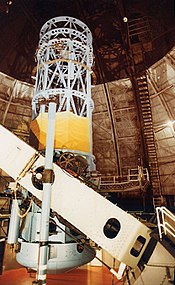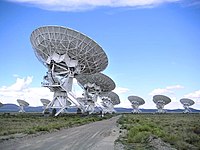| Revision as of 23:47, 23 June 2009 editInternetHero (talk | contribs)2,457 edits Major edit: Added sourced material per consensus found in talk-page.← Previous edit | Revision as of 00:08, 24 June 2009 edit undoWolfkeeper (talk | contribs)31,832 edits Revert to revision 295538154 dated 2009-06-10 07:46:52 by Szabozoltantamas using popupsNext edit → | ||
| Line 8: | Line 8: | ||
| ==History== | ==History== | ||
| {{main|History of the telescope}} | {{main|History of the telescope}} | ||
| The earliest evidence of working telescopes were the ]s that appeared in the ] in 1608. Their development is credited to three individuals: ] and ], who were spectacle makers in Middelburg, and ] of ].<ref></ref> ] greatly improved upon these designs the following year. | |||
| The idea that a mirror could be used as an ] instead of a lens was being investigated soon after the invention of the refracting telescope.<ref></ref> The potential advantages of using ], primarily reduction of ] with no ], led to many proposed designs and several attempts to build ]s.<ref>Attempts by ] and ] and theoretical designs by ], ], and ] among others</ref> In 1668, ] built the first practical reflecting telescope that bears his name, the ]. | The idea that a mirror could be used as an ] instead of a lens was being investigated soon after the invention of the refracting telescope.<ref></ref> The potential advantages of using ], primarily reduction of ] with no ], led to many proposed designs and several attempts to build ]s.<ref>Attempts by ] and ] and theoretical designs by ], ], and ] among others</ref> In 1668, ] built the first practical reflecting telescope that bears his name, the ]. | ||
Revision as of 00:08, 24 June 2009
For other uses, see Telescope (disambiguation).
A telescope is an instrument designed for the observation of remote objects by the collection of electromagnetic radiation. The first known practically functioning telescopes were invented in the Netherlands at the beginning of the 17th century. "Telescopes" can refer to a whole range of instruments operating in most regions of the electromagnetic spectrum.
The word "telescope" (from the Greek tele = 'far' and skopein = 'to look or see'; teleskopos = 'far-seeing') was coined in 1611 by the Greek mathematician Giovanni Demisiani for one of Galileo Galilei's instruments presented at a banquet at the Accademia dei Lincei. In the Starry Messenger Galileo had used the term "perspicillum".
History
Main article: History of the telescopeThe earliest evidence of working telescopes were the refracting telescopes that appeared in the Netherlands in 1608. Their development is credited to three individuals: Hans Lippershey and Zacharias Janssen, who were spectacle makers in Middelburg, and Jacob Metius of Alkmaar. Galileo greatly improved upon these designs the following year.
The idea that a mirror could be used as an objective instead of a lens was being investigated soon after the invention of the refracting telescope. The potential advantages of using parabolic mirrors, primarily reduction of spherical aberration with no chromatic aberration, led to many proposed designs and several attempts to build reflecting telescopes. In 1668, Isaac Newton built the first practical reflecting telescope that bears his name, the Newtonian reflector.
The invention of the achromatic lens in 1733 partially corrected color aberrations present in the simple lens and enabled the construction of shorter, more functional refracting telescopes. Reflecting telescopes, though not limited by the color problems seen in refractors, were hampered by the use of fast tarnishing speculum metal mirrors employed during the 18th and early 19th century—a problem alleviated by the introduction of silver coated glass mirrors in 1857, and aluminized mirrors in 1932. The maximum physical size limit for refracting telescopes is about 1 meter (40 inches), dictating that the vast majority of large optical researching telescopes built since the turn of the 20th century have been reflectors. The largest reflecting telescopes currently have objectives larger then 10 m (33 feet).
The 20th century also saw the development of telescopes that worked in a wide range of wavelengths from radio to gamma-rays. The first purpose built radio telescope went into operation in 1937. Since then, a tremendous variety of complex astronomical instruments have been developed.
Types of telescopes
| This article needs additional citations for verification. Please help improve this article by adding citations to reliable sources. Unsourced material may be challenged and removed. Find sources: "Telescope" – news · newspapers · books · scholar · JSTOR (July 2008) (Learn how and when to remove this message) |
The name "telescope" covers a wide range of instruments and is difficult to define. They all have the attribute of collecting electromagnetic radiation so it can be studied or analyzed in some manner. The most common type is the optical telescope; other types also exist and are listed below.
Optical telescopes

An optical telescope gathers and focuses light mainly from the visible part of the electromagnetic spectrum (although some work in the infrared and ultraviolet). Optical telescopes increase the apparent angular size of distant objects as well as their apparent brightness. In order for the image to be observed, photographed, studied, and sent to a computer, telescopes work by employing one or more curved optical elements—usually made from glass—lenses, or mirrors to gather light and other electromagnetic radiation to bring that light or radiation to a focal point. Optical telescopes are used for astronomy and in many non-astronomical instruments, including: theodolites (including transits), spotting scopes, monoculars, binoculars, camera lenses, and spyglasses. There are three main types:
- The refracting telescope which uses lenses to form an image.
- The reflecting telescope which uses an arrangement of mirrors to form an image.
- The catadioptric telescope which uses mirrors combined with lenses—either in front of the mirror or somewhere within the optical path—to form an image.
Other optical telescopes:
Radio telescopes
Main article: Radio telescope
Radio telescopes are directional radio antennas that often have a parabolic shape. The dishes are sometimes constructed of a conductive wire mesh whose openings are smaller than the wavelength being observed. Multi-element Radio telescopes are constructed from pairs or larger groups of these dishes to synthesize large 'virtual' apertures that are similar in size to the separation between the telescopes; this process is known as aperture synthesis. As of 2005, the current record array size is many times the width of the Earth—utilizing space-based Very Long Baseline Interferometry (VLBI) telescopes such as the Japanese HALCA (Highly Advanced Laboratory for Communications and Astronomy) VSOP (VLBI Space Observatory Program) satellite. Aperture synthesis is now also being applied to optical telescopes using optical interferometers (arrays of optical telescopes) and aperture masking interferometry at single reflecting telescopes. Radio telescopes are also used to collect microwave radiation, which is used to collect radiation when any visible light is obstructed or faint, such as from quasars. Some radio telescopes are used by programs such as SETI and the Arecibo Observatory to search for exterrestrial life. One particularly exciting example is the Wow! signal, recorded in 1977.
High energy particle telescopes

High-energy astronomy requires specialized telescopes to make observations since most of these particles go through most metals and glasses.
X-ray telescopes use Wolter telescopes composed of ring-shaped 'glancing' mirrors made of heavy metals that are able to reflect the rays just a few degrees. The mirrors are usually a section of a rotated parabola and a hyperbola, or ellipse. In 1952, Hans Wolter outlined 3 ways a telescope could be built using only this kind of mirror.
Gamma-ray telescopes refrain from focusing completely and use coded aperture masks: the patterns of the shadow the mask creates can be reconstructed to form an image.
X-ray and Gamma-ray telescopes are usually on Earth-orbiting satellites or high-flying balloons since the Earth's atmosphere is opaque to this part of the electromagnetic spectrum.
In other types of high energy particle telescopes there is no image-forming optical system. Cosmic-ray telescopes usually consist of an array of different detector types spread out over a large area. A Neutrino telescope consists of a large mass of water or ice, surrounded by an array of sensitive light detectors known as photomultiplier tubes.
Other types of telescopes

Lists of telescopes
- List of optical telescopes
- List of largest optical reflecting telescopes
- List of largest optical refracting telescopes
- List of largest optical telescopes historically
- list of radio telescopes
- List of space telescopes
- List of solar telescopes
- List of telescope types
- Category:Telescopes
- Category:Cosmic-ray telescopes
- Category:Gamma-ray telescopes
- Category:Gravitational wave telescopes
- Category:High energy particle telescopes
- Category:Infrared telescopes
- Category:Submillimetre telescopes
- Category:Ultraviolet telescopes
- Category:X-ray telescopes
See also
- Amateur telescope making
- Angular resolution
- Aperture synthesis
- ASCOM open standards for computer control of telescopes
- Depth of field
- Dynameter
- f-number
- First light
- Hartmann mask
- Keyhole problem
- Microscope
- Nimrud lens
- Remote Telescope Markup Language
- Robotic telescope
- Timeline of telescope technology
- Timeline of telescopes, observatories, and observing technology
Notes
- archive.org "Galileo His Life And Work" BY J. J. FAHIE "Galileo usually called the telescope occhicde or cannocchiale ; and now he calls the microscope occhialino. The name telescope was first suggested by Demisiani in 1612"
- Sobel (2000, p.43), Drake (1978, p.196)
- Rosen, Edward, The Naming of the Telescope (1947)
- galileo.rice.edu The Galileo Project > Science > The Telescope by Al Van Helden "The Hague discussed the patent applications first of Hans Lipperhey of Middelburg, and then of Jacob Metius of Alkmaar... another citizen of Middelburg, Sacharias Janssen had a telescope at about the same time but was at the Frankfurt Fair where he tried to sell it"
- Stargazer - By Fred Watson, Inc NetLibrary, Page 109
- Attempts by Niccolò Zucchi and James Gregory and theoretical designs by Bonaventura Cavalieri, Marin Mersenne, and Gregory among others
- madehow.com - Inventor Biographies - Jean-Bernard-Léon Foucault Biography (1819-1868)
- Bakich sample pages Chapter 2, Page 3 "John Donavan Strong, a young physicist at the California Institute of Technology, was one of the first to coat a mirror with aluminum. He did it by thermal vacuum evaporation. The first mirror he aluminized, in 1932, is the earliest known example of a telescope mirror coated by this technique."
- Wolter, H. (1952). "Glancing Incidence Mirror Systems as Imaging Optics for X-rays". Ann. Physik. 10: 94.
- Wolter, H. (1952). "A Generalized Schwarschild Mirror Systems For Use at Glancing Incidence for X-ray Imaging". Ann. Physik. 10: 286.
References
- Contemporary Astronomy - Second Edition, Jay M. Pasachoff, Saunders Colleges Publishing - 1981, ISBN 0-03-057861-2
- Template:Harvard reference
- Template:Harvard reference
- Template:Harvard reference
- Sabra, A. I. & Hogendijk, J. P. (2003), The Enterprise of Science in Islam: New Perspectives, MIT Press, pp. 85-118, ISBN 0262194821
External links
- The Galileo Project - The Telescope by Al Van Helden
- "The First Telescopes". Part of an exhibit from Cosmic Journey: A History of Scientific Cosmology by the American Institute of Physics
- Timeline of telescopic technology